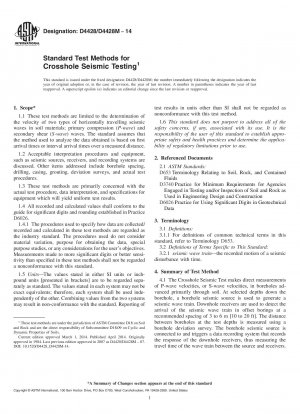ASTM D4428/D4428M-14
Standard Test Methods for Crosshole Seismic Testing
- Standard No.
- ASTM D4428/D4428M-14
- Release Date
- 2014
- Published By
- American Society for Testing and Materials (ASTM)
- Latest
- ASTM D4428/D4428M-14
- Scope
5.1 The seismic crosshole method provides a designer with information pertinent to the seismic wave velocities of the materials in question (1).2 This data may be used as follows:
5.1.1 For input into static/dynamic analyses;
5.1.2 For computing shear modulus, Young's modulus, and Poisson's ratio (provided density is known or assumed);
5.1.3 For determining Seismic Site Class using the appropriate Building Code; and
5.1.4 For assessing liquefaction potential.
5.2 Fundamental assumptions inherent in the test methods are as follows:
5.2.1 Horizontal layering is assumed.
5.2.2 Snell’s law of refraction applies to P-waves and S-waves and to the velocities derived from crosshole tests. If Snell’s law of refraction is not considered in the analysis of Crosshole seismic testing data, the report shall so state, and the P-wave and S-wave velocities obtained may be unreliable for certain depth intervals near changes in stratigraphy (2).
Note 1—The quality of the results produced by these test methods is dependent on the competence of the personnel performing it and the suitability of the equipment and facilities. Agencies that meet the criteria of Practice D3740 are generally considered capable of competent and objective testing/sampling/inspection and so forth. Users of these test methods are cautioned that compliance with Practice D3740 does not in itself assure reliable results. Reliable results depend on many factors; Practice D3740 provides a means of evaluating some of those factors.1.1 These test methods are limited to the determination of the velocity of two types of horizontally travelling seismic waves in soil materials; primary compression (P-wave) and secondary shear (S-wave) waves. The standard assumes that the method used to analyze the data obtained is based on first arrival times or interval arrival times over a measured distance.
1.2 Acceptable interpretation procedures and equipment, such as seismic sources, receivers, and recording systems are discussed. Other items addressed include borehole spacing, drilling, casing, grouting, deviation surveys, and actual test procedures.
1.3 These test methods are primarily concerned with the actual test procedure, data interpretation, and specifications for equipment which will yield uniform test results.
1.4 All recorded and calculated values shall conform to the guide for significant digits and rounding established in Practice D6026.
1.4.1 The procedures used to specify how data are collected/recorded and calculated in these test methods are regarded as the industry standard. The procedures used do not consider material variation, purpose for obtaining the data, special purpose studies, or any considerations for the user’s objectives. Measurements made to more significant digits or better ......
ASTM D4428/D4428M-14 Referenced Document
- ASTM D3740 Standard Practice for Minimum Requirements for Agencies Engaged in the Testing and/or Inspection of Soil and Rock as Used in Engineering Design and Construction
- ASTM D6026 Standard Practice for Using Significant Digits in Geotechnical Data
- ASTM D653 Standard Terminology Relating to Soil, Rock, and Contained Fluids
ASTM D4428/D4428M-14 history
- 2014 ASTM D4428/D4428M-14 Standard Test Methods for Crosshole Seismic Testing
- 2007 ASTM D4428/D4428M-07 Standard Test Methods for Crosshole Seismic Testing
- 2000 ASTM D4428/D4428M-00 Standard Test Methods for Crosshole Seismic Testing

Copyright ©2024 All Rights Reserved